Ethical Implications of Automation: A BBA 2 Case Study
VerifiedAdded on 2020/05/11
|7
|1595
|49
Case Study
AI Summary
This case study examines the ethical implications of automation in a business setting. It focuses on a scenario where engineers automate their tasks, leading to questions about the ethical use of company time and resources. The case explores the perspectives of both employees and the organization, considering the potential benefits and drawbacks of automation, such as increased efficiency versus job security concerns. The analysis delves into the ethical dilemma of whether automating tasks without explicit permission is acceptable, and examines alternative courses of action, including informing management and proposing company-wide automation strategies. The paper applies ethical frameworks, including consequentialist and non-consequentialist theories, to evaluate the actions of the employees and the potential outcomes. The case study concludes with a proposed solution that emphasizes the importance of transparency, ethical decision-making, and aligning automation efforts with the greater good of the organization. It also addresses the need for employee training and the potential for career development, along with the importance of leaders providing constructive feedback and appreciating their employees' efforts. The provided references support the analysis with relevant literature on business ethics and automation.

Running head: BBA
BBA
Name of the Student
Name of the University
Author note
BBA
Name of the Student
Name of the University
Author note
Paraphrase This Document
Need a fresh take? Get an instant paraphrase of this document with our AI Paraphraser
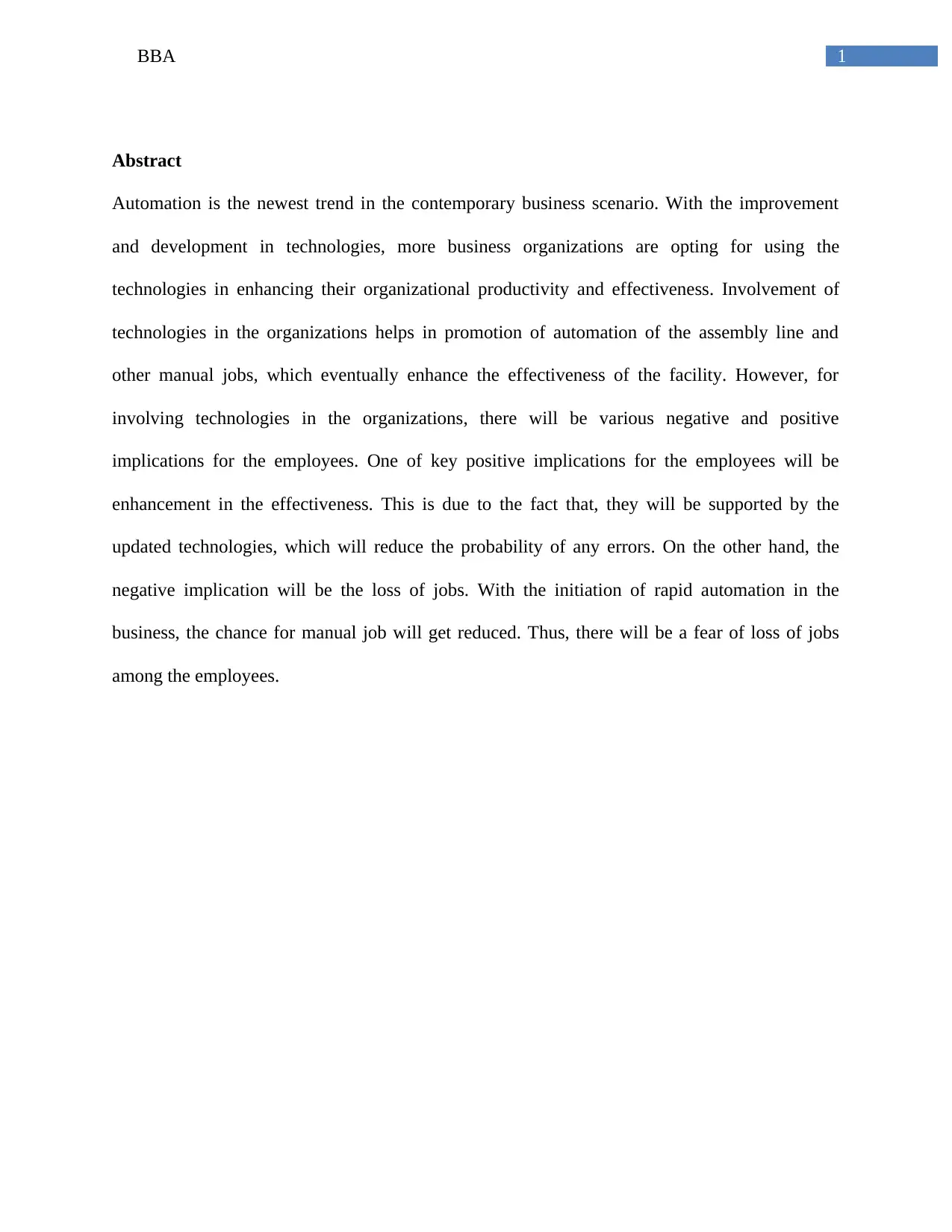
1BBA
Abstract
Automation is the newest trend in the contemporary business scenario. With the improvement
and development in technologies, more business organizations are opting for using the
technologies in enhancing their organizational productivity and effectiveness. Involvement of
technologies in the organizations helps in promotion of automation of the assembly line and
other manual jobs, which eventually enhance the effectiveness of the facility. However, for
involving technologies in the organizations, there will be various negative and positive
implications for the employees. One of key positive implications for the employees will be
enhancement in the effectiveness. This is due to the fact that, they will be supported by the
updated technologies, which will reduce the probability of any errors. On the other hand, the
negative implication will be the loss of jobs. With the initiation of rapid automation in the
business, the chance for manual job will get reduced. Thus, there will be a fear of loss of jobs
among the employees.
Abstract
Automation is the newest trend in the contemporary business scenario. With the improvement
and development in technologies, more business organizations are opting for using the
technologies in enhancing their organizational productivity and effectiveness. Involvement of
technologies in the organizations helps in promotion of automation of the assembly line and
other manual jobs, which eventually enhance the effectiveness of the facility. However, for
involving technologies in the organizations, there will be various negative and positive
implications for the employees. One of key positive implications for the employees will be
enhancement in the effectiveness. This is due to the fact that, they will be supported by the
updated technologies, which will reduce the probability of any errors. On the other hand, the
negative implication will be the loss of jobs. With the initiation of rapid automation in the
business, the chance for manual job will get reduced. Thus, there will be a fear of loss of jobs
among the employees.
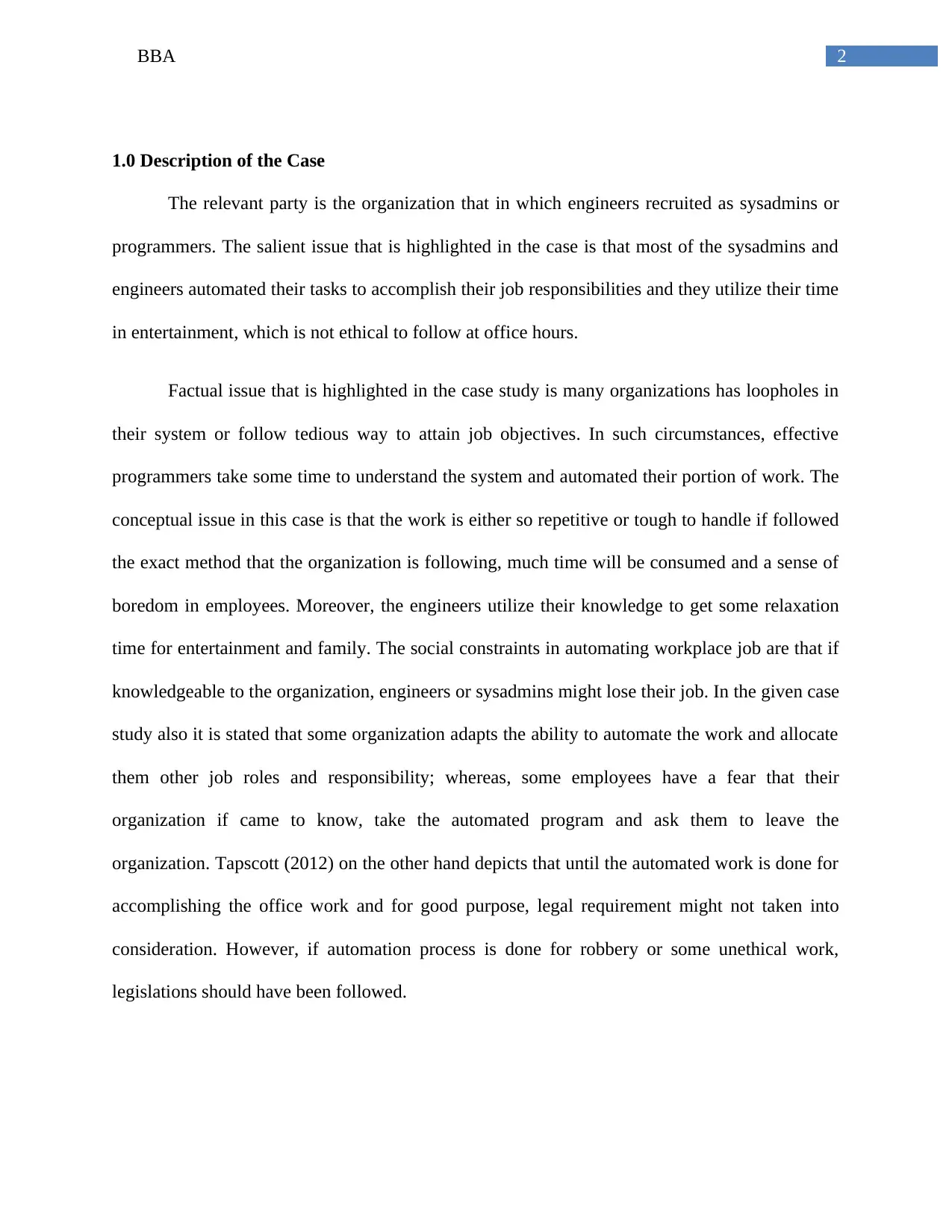
2BBA
1.0 Description of the Case
The relevant party is the organization that in which engineers recruited as sysadmins or
programmers. The salient issue that is highlighted in the case is that most of the sysadmins and
engineers automated their tasks to accomplish their job responsibilities and they utilize their time
in entertainment, which is not ethical to follow at office hours.
Factual issue that is highlighted in the case study is many organizations has loopholes in
their system or follow tedious way to attain job objectives. In such circumstances, effective
programmers take some time to understand the system and automated their portion of work. The
conceptual issue in this case is that the work is either so repetitive or tough to handle if followed
the exact method that the organization is following, much time will be consumed and a sense of
boredom in employees. Moreover, the engineers utilize their knowledge to get some relaxation
time for entertainment and family. The social constraints in automating workplace job are that if
knowledgeable to the organization, engineers or sysadmins might lose their job. In the given case
study also it is stated that some organization adapts the ability to automate the work and allocate
them other job roles and responsibility; whereas, some employees have a fear that their
organization if came to know, take the automated program and ask them to leave the
organization. Tapscott (2012) on the other hand depicts that until the automated work is done for
accomplishing the office work and for good purpose, legal requirement might not taken into
consideration. However, if automation process is done for robbery or some unethical work,
legislations should have been followed.
1.0 Description of the Case
The relevant party is the organization that in which engineers recruited as sysadmins or
programmers. The salient issue that is highlighted in the case is that most of the sysadmins and
engineers automated their tasks to accomplish their job responsibilities and they utilize their time
in entertainment, which is not ethical to follow at office hours.
Factual issue that is highlighted in the case study is many organizations has loopholes in
their system or follow tedious way to attain job objectives. In such circumstances, effective
programmers take some time to understand the system and automated their portion of work. The
conceptual issue in this case is that the work is either so repetitive or tough to handle if followed
the exact method that the organization is following, much time will be consumed and a sense of
boredom in employees. Moreover, the engineers utilize their knowledge to get some relaxation
time for entertainment and family. The social constraints in automating workplace job are that if
knowledgeable to the organization, engineers or sysadmins might lose their job. In the given case
study also it is stated that some organization adapts the ability to automate the work and allocate
them other job roles and responsibility; whereas, some employees have a fear that their
organization if came to know, take the automated program and ask them to leave the
organization. Tapscott (2012) on the other hand depicts that until the automated work is done for
accomplishing the office work and for good purpose, legal requirement might not taken into
consideration. However, if automation process is done for robbery or some unethical work,
legislations should have been followed.
⊘ This is a preview!⊘
Do you want full access?
Subscribe today to unlock all pages.

Trusted by 1+ million students worldwide
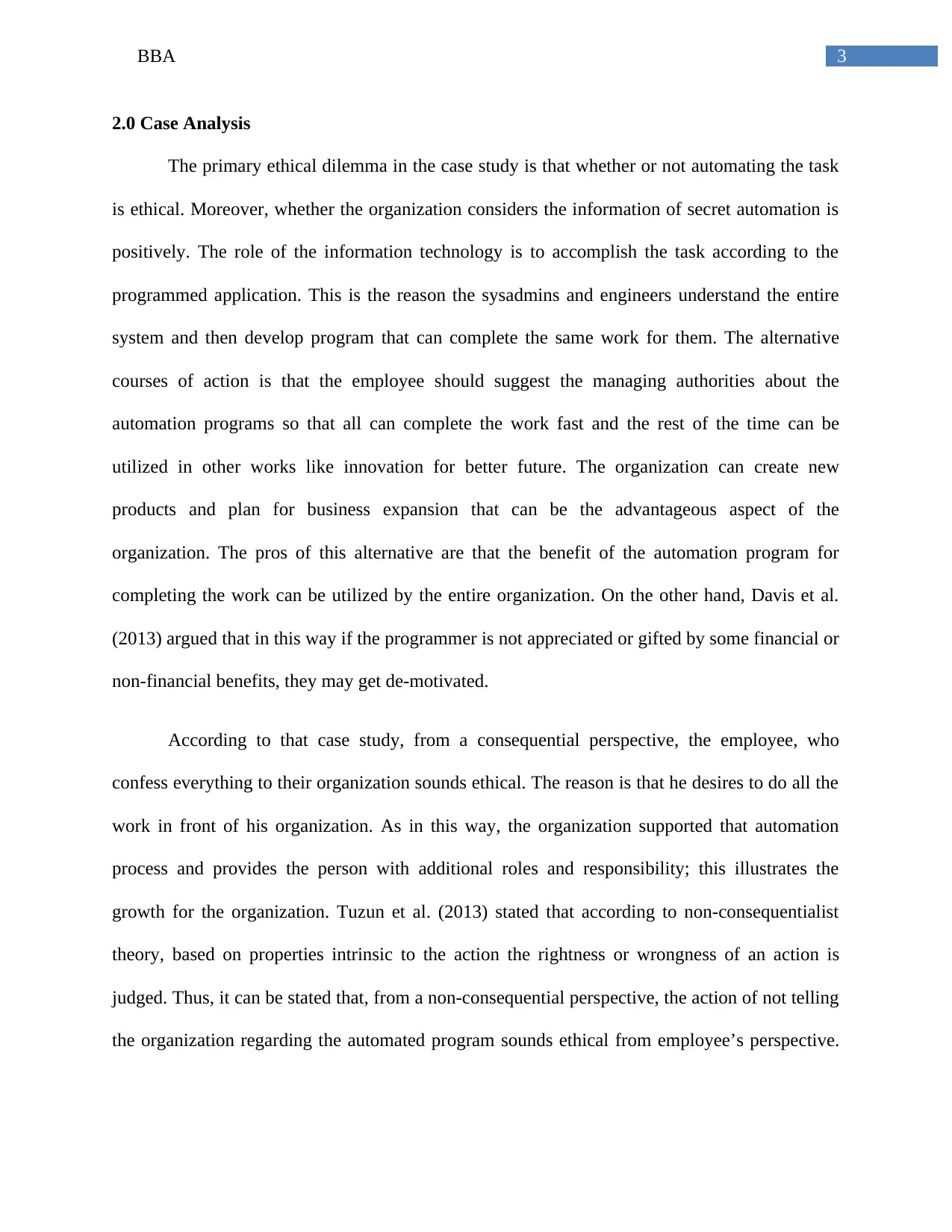
3BBA
2.0 Case Analysis
The primary ethical dilemma in the case study is that whether or not automating the task
is ethical. Moreover, whether the organization considers the information of secret automation is
positively. The role of the information technology is to accomplish the task according to the
programmed application. This is the reason the sysadmins and engineers understand the entire
system and then develop program that can complete the same work for them. The alternative
courses of action is that the employee should suggest the managing authorities about the
automation programs so that all can complete the work fast and the rest of the time can be
utilized in other works like innovation for better future. The organization can create new
products and plan for business expansion that can be the advantageous aspect of the
organization. The pros of this alternative are that the benefit of the automation program for
completing the work can be utilized by the entire organization. On the other hand, Davis et al.
(2013) argued that in this way if the programmer is not appreciated or gifted by some financial or
non-financial benefits, they may get de-motivated.
According to that case study, from a consequential perspective, the employee, who
confess everything to their organization sounds ethical. The reason is that he desires to do all the
work in front of his organization. As in this way, the organization supported that automation
process and provides the person with additional roles and responsibility; this illustrates the
growth for the organization. Tuzun et al. (2013) stated that according to non-consequentialist
theory, based on properties intrinsic to the action the rightness or wrongness of an action is
judged. Thus, it can be stated that, from a non-consequential perspective, the action of not telling
the organization regarding the automated program sounds ethical from employee’s perspective.
2.0 Case Analysis
The primary ethical dilemma in the case study is that whether or not automating the task
is ethical. Moreover, whether the organization considers the information of secret automation is
positively. The role of the information technology is to accomplish the task according to the
programmed application. This is the reason the sysadmins and engineers understand the entire
system and then develop program that can complete the same work for them. The alternative
courses of action is that the employee should suggest the managing authorities about the
automation programs so that all can complete the work fast and the rest of the time can be
utilized in other works like innovation for better future. The organization can create new
products and plan for business expansion that can be the advantageous aspect of the
organization. The pros of this alternative are that the benefit of the automation program for
completing the work can be utilized by the entire organization. On the other hand, Davis et al.
(2013) argued that in this way if the programmer is not appreciated or gifted by some financial or
non-financial benefits, they may get de-motivated.
According to that case study, from a consequential perspective, the employee, who
confess everything to their organization sounds ethical. The reason is that he desires to do all the
work in front of his organization. As in this way, the organization supported that automation
process and provides the person with additional roles and responsibility; this illustrates the
growth for the organization. Tuzun et al. (2013) stated that according to non-consequentialist
theory, based on properties intrinsic to the action the rightness or wrongness of an action is
judged. Thus, it can be stated that, from a non-consequential perspective, the action of not telling
the organization regarding the automated program sounds ethical from employee’s perspective.
Paraphrase This Document
Need a fresh take? Get an instant paraphrase of this document with our AI Paraphraser
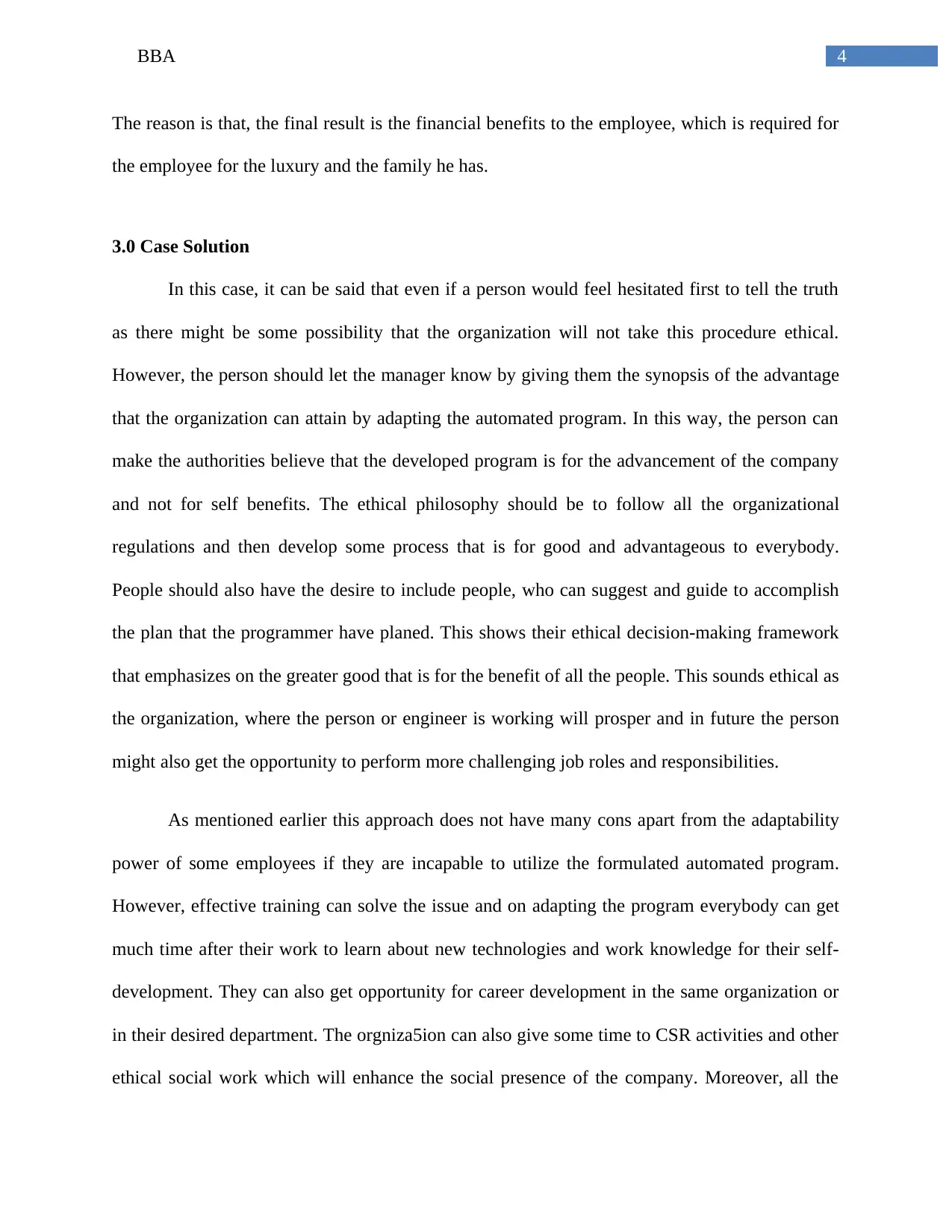
4BBA
The reason is that, the final result is the financial benefits to the employee, which is required for
the employee for the luxury and the family he has.
3.0 Case Solution
In this case, it can be said that even if a person would feel hesitated first to tell the truth
as there might be some possibility that the organization will not take this procedure ethical.
However, the person should let the manager know by giving them the synopsis of the advantage
that the organization can attain by adapting the automated program. In this way, the person can
make the authorities believe that the developed program is for the advancement of the company
and not for self benefits. The ethical philosophy should be to follow all the organizational
regulations and then develop some process that is for good and advantageous to everybody.
People should also have the desire to include people, who can suggest and guide to accomplish
the plan that the programmer have planed. This shows their ethical decision-making framework
that emphasizes on the greater good that is for the benefit of all the people. This sounds ethical as
the organization, where the person or engineer is working will prosper and in future the person
might also get the opportunity to perform more challenging job roles and responsibilities.
As mentioned earlier this approach does not have many cons apart from the adaptability
power of some employees if they are incapable to utilize the formulated automated program.
However, effective training can solve the issue and on adapting the program everybody can get
much time after their work to learn about new technologies and work knowledge for their self-
development. They can also get opportunity for career development in the same organization or
in their desired department. The orgniza5ion can also give some time to CSR activities and other
ethical social work which will enhance the social presence of the company. Moreover, all the
The reason is that, the final result is the financial benefits to the employee, which is required for
the employee for the luxury and the family he has.
3.0 Case Solution
In this case, it can be said that even if a person would feel hesitated first to tell the truth
as there might be some possibility that the organization will not take this procedure ethical.
However, the person should let the manager know by giving them the synopsis of the advantage
that the organization can attain by adapting the automated program. In this way, the person can
make the authorities believe that the developed program is for the advancement of the company
and not for self benefits. The ethical philosophy should be to follow all the organizational
regulations and then develop some process that is for good and advantageous to everybody.
People should also have the desire to include people, who can suggest and guide to accomplish
the plan that the programmer have planed. This shows their ethical decision-making framework
that emphasizes on the greater good that is for the benefit of all the people. This sounds ethical as
the organization, where the person or engineer is working will prosper and in future the person
might also get the opportunity to perform more challenging job roles and responsibilities.
As mentioned earlier this approach does not have many cons apart from the adaptability
power of some employees if they are incapable to utilize the formulated automated program.
However, effective training can solve the issue and on adapting the program everybody can get
much time after their work to learn about new technologies and work knowledge for their self-
development. They can also get opportunity for career development in the same organization or
in their desired department. The orgniza5ion can also give some time to CSR activities and other
ethical social work which will enhance the social presence of the company. Moreover, all the
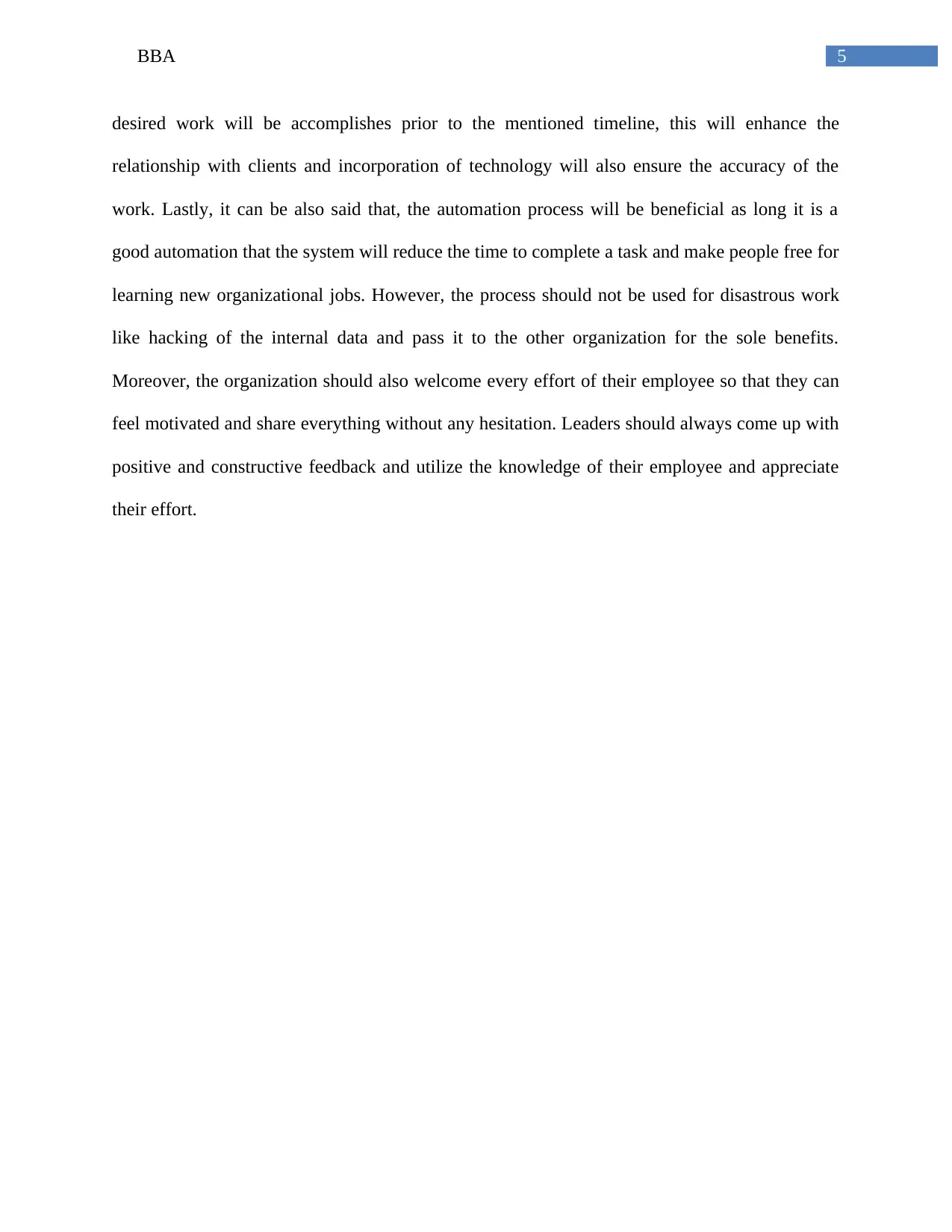
5BBA
desired work will be accomplishes prior to the mentioned timeline, this will enhance the
relationship with clients and incorporation of technology will also ensure the accuracy of the
work. Lastly, it can be also said that, the automation process will be beneficial as long it is a
good automation that the system will reduce the time to complete a task and make people free for
learning new organizational jobs. However, the process should not be used for disastrous work
like hacking of the internal data and pass it to the other organization for the sole benefits.
Moreover, the organization should also welcome every effort of their employee so that they can
feel motivated and share everything without any hesitation. Leaders should always come up with
positive and constructive feedback and utilize the knowledge of their employee and appreciate
their effort.
desired work will be accomplishes prior to the mentioned timeline, this will enhance the
relationship with clients and incorporation of technology will also ensure the accuracy of the
work. Lastly, it can be also said that, the automation process will be beneficial as long it is a
good automation that the system will reduce the time to complete a task and make people free for
learning new organizational jobs. However, the process should not be used for disastrous work
like hacking of the internal data and pass it to the other organization for the sole benefits.
Moreover, the organization should also welcome every effort of their employee so that they can
feel motivated and share everything without any hesitation. Leaders should always come up with
positive and constructive feedback and utilize the knowledge of their employee and appreciate
their effort.
⊘ This is a preview!⊘
Do you want full access?
Subscribe today to unlock all pages.

Trusted by 1+ million students worldwide
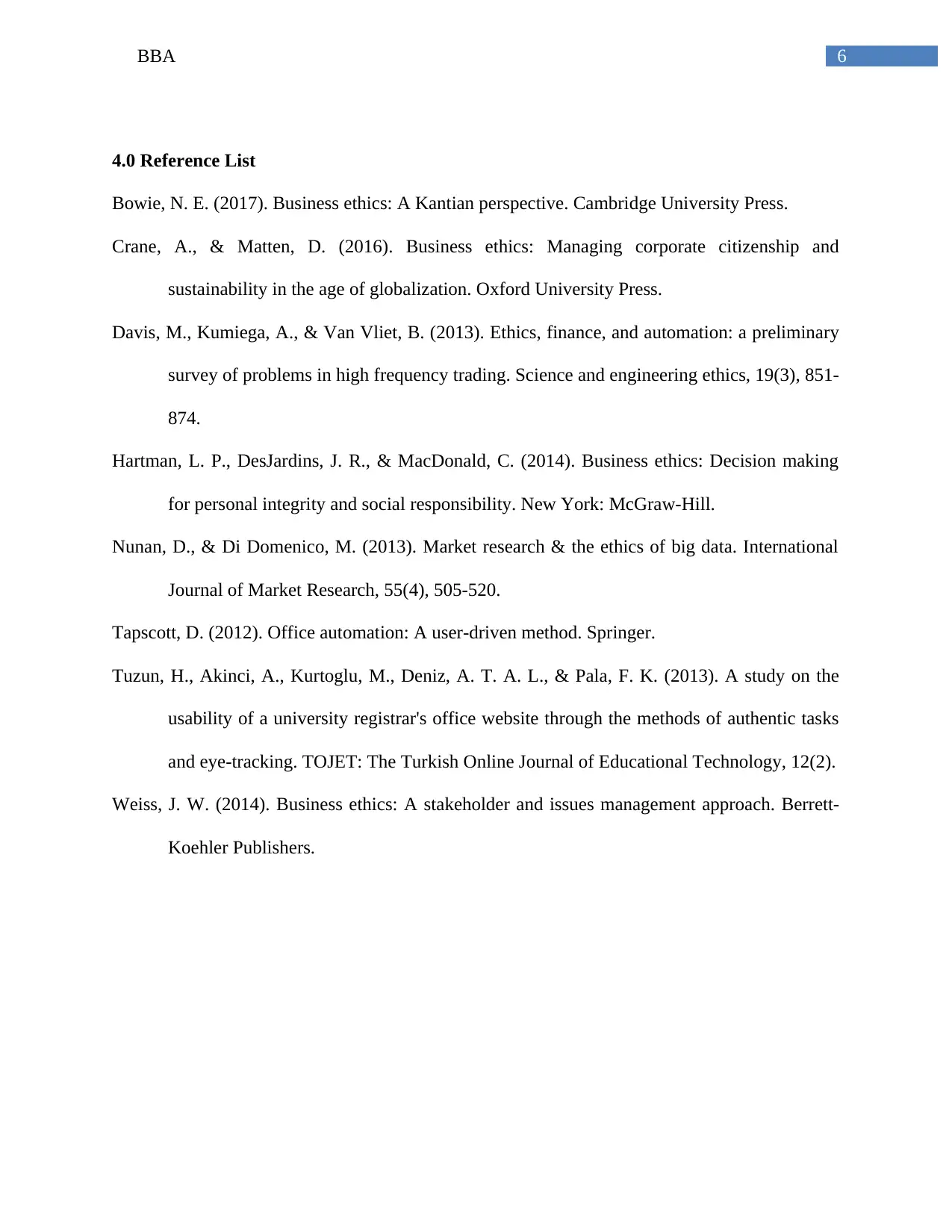
6BBA
4.0 Reference List
Bowie, N. E. (2017). Business ethics: A Kantian perspective. Cambridge University Press.
Crane, A., & Matten, D. (2016). Business ethics: Managing corporate citizenship and
sustainability in the age of globalization. Oxford University Press.
Davis, M., Kumiega, A., & Van Vliet, B. (2013). Ethics, finance, and automation: a preliminary
survey of problems in high frequency trading. Science and engineering ethics, 19(3), 851-
874.
Hartman, L. P., DesJardins, J. R., & MacDonald, C. (2014). Business ethics: Decision making
for personal integrity and social responsibility. New York: McGraw-Hill.
Nunan, D., & Di Domenico, M. (2013). Market research & the ethics of big data. International
Journal of Market Research, 55(4), 505-520.
Tapscott, D. (2012). Office automation: A user-driven method. Springer.
Tuzun, H., Akinci, A., Kurtoglu, M., Deniz, A. T. A. L., & Pala, F. K. (2013). A study on the
usability of a university registrar's office website through the methods of authentic tasks
and eye-tracking. TOJET: The Turkish Online Journal of Educational Technology, 12(2).
Weiss, J. W. (2014). Business ethics: A stakeholder and issues management approach. Berrett-
Koehler Publishers.
4.0 Reference List
Bowie, N. E. (2017). Business ethics: A Kantian perspective. Cambridge University Press.
Crane, A., & Matten, D. (2016). Business ethics: Managing corporate citizenship and
sustainability in the age of globalization. Oxford University Press.
Davis, M., Kumiega, A., & Van Vliet, B. (2013). Ethics, finance, and automation: a preliminary
survey of problems in high frequency trading. Science and engineering ethics, 19(3), 851-
874.
Hartman, L. P., DesJardins, J. R., & MacDonald, C. (2014). Business ethics: Decision making
for personal integrity and social responsibility. New York: McGraw-Hill.
Nunan, D., & Di Domenico, M. (2013). Market research & the ethics of big data. International
Journal of Market Research, 55(4), 505-520.
Tapscott, D. (2012). Office automation: A user-driven method. Springer.
Tuzun, H., Akinci, A., Kurtoglu, M., Deniz, A. T. A. L., & Pala, F. K. (2013). A study on the
usability of a university registrar's office website through the methods of authentic tasks
and eye-tracking. TOJET: The Turkish Online Journal of Educational Technology, 12(2).
Weiss, J. W. (2014). Business ethics: A stakeholder and issues management approach. Berrett-
Koehler Publishers.
1 out of 7
Related Documents
Your All-in-One AI-Powered Toolkit for Academic Success.
+13062052269
info@desklib.com
Available 24*7 on WhatsApp / Email
![[object Object]](/_next/static/media/star-bottom.7253800d.svg)
Unlock your academic potential
Copyright © 2020–2025 A2Z Services. All Rights Reserved. Developed and managed by ZUCOL.




